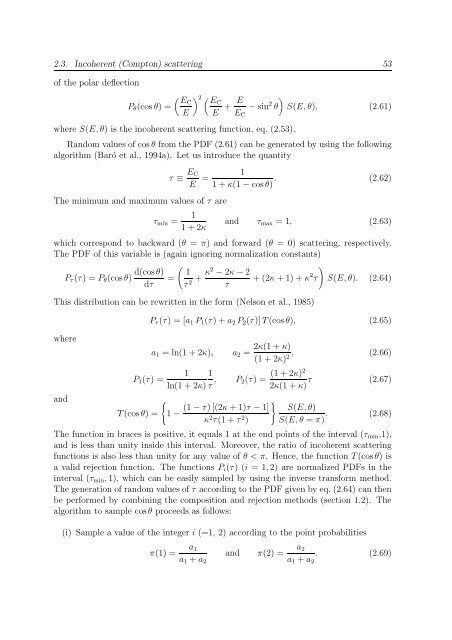PENELOPE 2003 - OECD Nuclear Energy Agency
PENELOPE 2003 - OECD Nuclear Energy Agency
PENELOPE 2003 - OECD Nuclear Energy Agency
You also want an ePaper? Increase the reach of your titles
YUMPU automatically turns print PDFs into web optimized ePapers that Google loves.
2.3. Incoherent (Compton) scattering 53<br />
of the polar deflection<br />
P θ (cos θ) =<br />
( EC<br />
E<br />
) 2 ( EC<br />
E + E )<br />
− sin 2 θ S(E, θ), (2.61)<br />
E C<br />
where S(E, θ) is the incoherent scattering function, eq. (2.53).<br />
Random values of cos θ from the PDF (2.61) can be generated by using the following<br />
algorithm (Baró et al., 1994a). Let us introduce the quantity<br />
The minimum and maximum values of τ are<br />
τ ≡ E C<br />
E = 1<br />
1 + κ(1 − cos θ) . (2.62)<br />
τ min = 1<br />
1 + 2κ<br />
and τ max = 1, (2.63)<br />
which correspond to backward (θ = π) and forward (θ = 0) scattering, respectively.<br />
The PDF of this variable is (again ignoring normalization constants)<br />
( )<br />
d(cos θ) 1<br />
P τ (τ) = P θ (cos θ) =<br />
dτ τ + κ2 − 2κ − 2<br />
+ (2κ + 1) + κ 2 τ S(E, θ). (2.64)<br />
2 τ<br />
This distribution can be rewritten in the form (Nelson et al., 1985)<br />
where<br />
and<br />
P 1 (τ) =<br />
T (cos θ) =<br />
P τ (τ) = [a 1 P 1 (τ) + a 2 P 2 (τ)] T (cos θ), (2.65)<br />
a 1 = ln(1 + 2κ), a 2 =<br />
{<br />
1 1<br />
ln(1 + 2κ) τ , P 2(τ) =<br />
1 −<br />
2κ(1 + κ)<br />
(1 + 2κ) 2 , (2.66)<br />
(1 + 2κ)2<br />
2κ(1 + κ) τ (2.67)<br />
}<br />
(1 − τ) [(2κ + 1)τ − 1] S(E, θ)<br />
κ 2 τ(1 + τ 2 ) S(E, θ = π) . (2.68)<br />
The function in braces is positive, it equals 1 at the end points of the interval (τ min ,1),<br />
and is less than unity inside this interval. Moreover, the ratio of incoherent scattering<br />
functions is also less than unity for any value of θ < π. Hence, the function T (cos θ) is<br />
a valid rejection function. The functions P i (τ) (i = 1, 2) are normalized PDFs in the<br />
interval (τ min , 1), which can be easily sampled by using the inverse transform method.<br />
The generation of random values of τ according to the PDF given by eq. (2.64) can then<br />
be performed by combining the composition and rejection methods (section 1.2). The<br />
algorithm to sample cos θ proceeds as follows:<br />
(i) Sample a value of the integer i (=1, 2) according to the point probabilities<br />
π(1) = a 1<br />
a 1 + a 2<br />
and π(2) = a 2<br />
a 1 + a 2<br />
. (2.69)
















